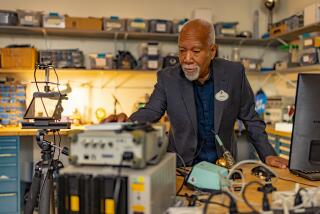They aspire to be movers and shakers in a motion-sensor revolution
- Share via
While rising to chief technology officer for Magellan Navigation in the 1990s, Anatole Lokshin pioneered the use of the global positioning system in everyday life, bringing the satellite-based technology to boats, cars and eventually cellphones.
Now, running a startup with his son, the Huntington Beach inventor wants to latch sophisticated motion sensors onto surfboards, skateboards, snowboards and regular clothing.
Data collected by Lokshin’s sensors could separate pros from posers in sports that typically emphasize imprecise metrics such as style points.
In the long run, the precise data collected by a device, about the size of a Reese’s peanut butter cup, could improve athletic training, speed injury recovery and motivate people to live healthier lives.
“I was lucky to participate in one revolution, and now I believe this will be a second one,” Lokshin, 61, said. “Sensors will be everywhere.”
Three years ago, Lokshin and his son David founded AlpineReplay Inc. in a bid to make “action sports shareable and comparable.” They built a smartphone app that enables skiers and snowboarders to measure their speed, distance and jumps — and share all of that almost instantly on social media.
People including teenagers and retired 50-year-olds loved the added competition and became loyal users. Hundreds of thousands of people have recorded more than 2.5 million jumps at 14,000 resorts.
But Lokshin knew a dedicated tool with higher-quality sensors could provide more valuable feedback and better withstand rugged — or wet — terrain.
They engineered Trace, a “shockproof, waterproof and durable” rubber-covered plastic pod that looks like a hockey puck. It locks into a mount glued onto sports equipment. Inside the pods are sensors, a computer processor and a micro-USB-charged, seven-hour battery.
An accelerometer tracks acceleration and tilt. A gyroscope measures rotation. A magnetic sensor gives absolute direction. A thermometer adds weather to the equation. And of course, there’s an advanced GPS chip. When connected to a computer, Trace uploads the sensor readings online.
The technology’s magic is taking the conflicting and messy data each sensor provides and ironing it into graphics a 5-year-old could understand.
“What we’re doing that’s unique is figuring out what trick you’ve done and how you’ve done it and telling you in the terms you like and the language you use,” Lokshin said.
The Trace code can already identify skateboard tricks such as ollies and kickflips.
Like hand-held GPS, Trace marks an evolution of military technology built to keep submarines and missiles on course, for example. Putting GPS in everyone’s hands became a $20-billion industry. Lokshin is hoping to engineer a similar wave with the inertial sensors.
The company, which goes by the marketing name ActiveReplay, is raising funds from the public through crowd-sourcing website Kickstarter to manufacture 2,000 Trace pods, with plans to ship them next spring.
The expected retail value: $149. But ActiveReplay might be able to minimize the cost and instead charge for the statistical analysis service.
Lokshin grew up in the Soviet Union before immigrating to the U.S. in 1979. After graduating from USC in 1989 with a master’s degree in electrical engineering, he started his career hunting for intelligent life in space and working on the Mars rover project at NASA’s Jet Propulsion Laboratory.
But he wanted the faster pace of working for a company that develops products. As he explained it, “building a new product every six months or dying.”
He arrived at Magellan’s San Dimas engineering center barely understanding GPS satellite technology. But he left having been one of the first people to write the code that turns latitude and longitude coordinates into the sleek digital maps that many now use daily.
Lokshin said the public didn’t recognize GPS in 1993. Yet Magellan had a vision of its being everywhere. About four years ago, he recognized that the dream had been realized and eyed sensors as the next hot market.
“If you think about Facebook or whatever you do online, it’s so focused on our mental life — what we talk about,” Lokshin said. “Sensors would allow us to show what you are actually doing — an objective way to map our lives without having to do any talking.”
Both Lokshin and his son turned in resignation letters on the same day in 2009 without the other one knowing. David had been an options trader in Singapore after graduating from Harvard University with a bachelor’s degree in applied mathematics. His heart remained in California, where had had grown up hacking computers, surfing and skateboarding.
They landed in Huntington Beach and began championing inertial sensors.
Technology and sports experts agree that Trace would be indispensable for high-level athletes, especially if paired with a GoPro extreme-action camera to meld feedback to video.
“For competitive athletes in action sports, the price for Trace is a drop in the bucket and they do love their toys,” said Jenny O, a kinesiology professor at Cal State East Bay.
But Brian Blau, a consumer technology analyst for Gartner Inc., worried that the extreme-sports niche was too limited for Trace to succeed because most people don’t need perfect feedback.
“It’s hard to say how important this data is and if it will make a difference for the general consumer audience,” Blau said.
Trace also faces many competitors. A watch-like tracking device called Lit is expected to launch this fall. Xensr, a sensor-laden shell for newer iPods and iPhones, is another. More than three dozen technology companies are developing tracking devices as well, Blau said.
Still, experts see potential uses for Trace in the health world. Besides helping athletes iron out kinks in their mechanics, physical therapy patients could pinpoint weak spots with never-before-seen accuracy.
And Anatole said he has no doubt that within the next few years everything people do will begin to be measured and analyzed in detail. As more data are collected, new sciences will emerge.
“Smart helmets. Smart keyboards,” he said. “We definitely want to be a driving force for that transformation.”
Twitter: @peard33
More to Read
Inside the business of entertainment
The Wide Shot brings you news, analysis and insights on everything from streaming wars to production — and what it all means for the future.
You may occasionally receive promotional content from the Los Angeles Times.











